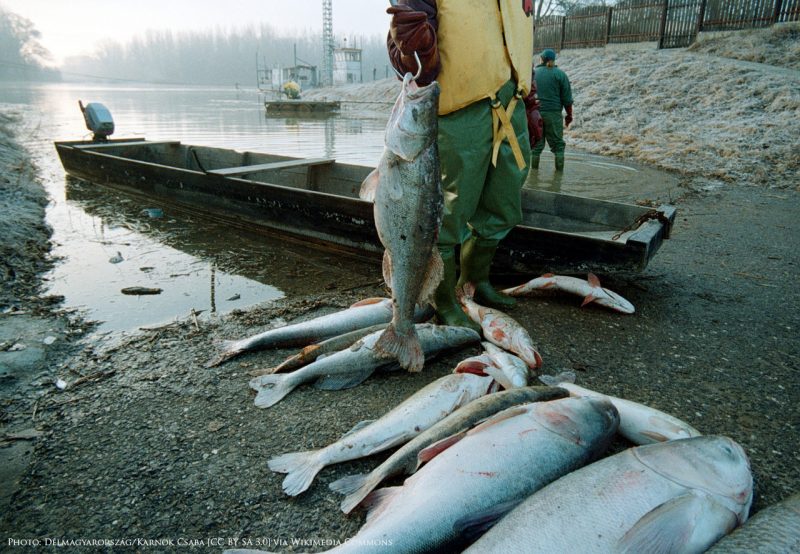Le onde di cianuro nel Danubio
Il cianuro, uno dei più potenti agenti tossici per tutti gli esseri viventi, viene utilizzato nell’industria mineraria per l’estrazione dell’oro, cui conferisce risalto nel momento in cui vi si lega chimicamente. Ma l’utilizzo di questa sostanza provoca ingenti danni ambientali: il caso più famoso è avvenuto in Romania nel 2000.
Le abbondanti piogge cadute per quasi 24 ore il 30 gennaio 2000 hanno causato la fuoriuscita di metalli pesanti e cianuro dal bacino di decantazione della miniera d’Oro Esmeralda presso la località di Baia Mare, nel Nord-Ovest del Paese. Una quantità compresa tra 100 mila e 300 mila metri cubi di cianuro si sono riversati nel fiume Tibisco, le cui acque confluiscono nel Danubio.
Le conseguenze ambientali furono così drammatiche da far ricordare l’evento come la seconda più grave catastrofe ambientale europea dopo Chernobyl. L’acqua contaminata ha spazzato via ogni forma di vita nel Tibisco e nello Smamos: circa 1.400 tonnellate di pesci sono state uccisi dal cianuro. Dopo poche settimane, la marea di sostanza tossica si riversò nelle acque del Danubio, mettendo in pericolo il più importante serbatoio ittico e di avifauna d’Europa e compromettendo anche molte sorgenti di acqua potabile in diverse città ungheresi e romene per diversi giorni.
Le dinamiche dell’incidente non sono molto chiare. Secondo la società Esmeralda Ltd rumeno-australiana il fenomeno è dovuto a cause naturali: il disgelo e le piogge hanno fatto tracimare la diga che chiudeva il bacino facendo fuoriuscire l’acqua contaminata. Secondo gli ambientalisti, invece, la causa risiede proprio nella gestione dei bacini, che non sarebbero sufficientemente sicuri e la manutenzione della diga non adeguata a prevenire questo genere di incidenti. La compagnia mineraria australiana, considerata quindi responsabile della perdita di cianuro, dichiarò il fallimento: non ci fu quindi alcun risarcimento per questo disastro, il più imponente della storia che ha interessato un sistema fluviale. Né alcuna ricerca epidemiologica è stata condotta negli anni successivi per quantificare e qualificare i possibili effetti di cianuro sulla salute delle milioni di persone che abitano nelle zone del bacino del Danubio.
Location
Romania, Transylvania, Maramureş County, Baia Mare https://www.google.it/maps/place/Baia+Mare,+Romania/@47.6689834,23.5008264,12z/data=!3m1!4b1!4m12!1m6!3m5!1s0x47490e96c469c0d9:0xaaec7c61bb9f5e70!2sBaia+Mare!8m2!3d46.777316!4d23.576372!3m4!1s0x4737dc70b4206f37:0x30914e534fa9d1dd!8m2!3d47.657063!4d23.5848999
Environmental impact
- Water pollution
- Land degradation (e.g. drought, soil contamination, erosion and desertification)
- Biodiversity loss – Ecosystem destruction
- Depletion of natural resources (fossil and mineral, forest, water, etc)
- Waste, waste disposal, and toxicants
Ethical/ legal issues
- Health and well-being
- A clean and prosperous environment and a safe and pleasant habitat
Information sources & materials
Online books and newspaper, magazine, encyclopedia, or blog articles
- http://www.lastampa.it/2013/08/05/scienza/ambiente/focus/ecco-le-dodici-pi-gravi-sciagure-ambientali-yacwN3iJ9Px0PrXmJaB6NK/pagina.html
- https://www.greenme.it/informarsi/ambiente/10699-sporca-dozzina-12-crimini-contro-ambiente
- http://ricerca.repubblica.it/repubblica/archivio/repubblica/2000/02/12/il-cianuro-avvelena-il-danubio-catastrofe-nel.html
- http://www.repubblica.it/online/mondo/danubio/danubio/danubio.html
- http://ricerca.repubblica.it/repubblica/archivio/repubblica/2000/02/13/la-catastrofe-del-paradiso-europa.html
- https://www.theguardian.com/world/2000/feb/14/1
Contributor(s)
Leila Belhadj Mohamed, Italy



Home › Forums › The cyanide waves in the Danube